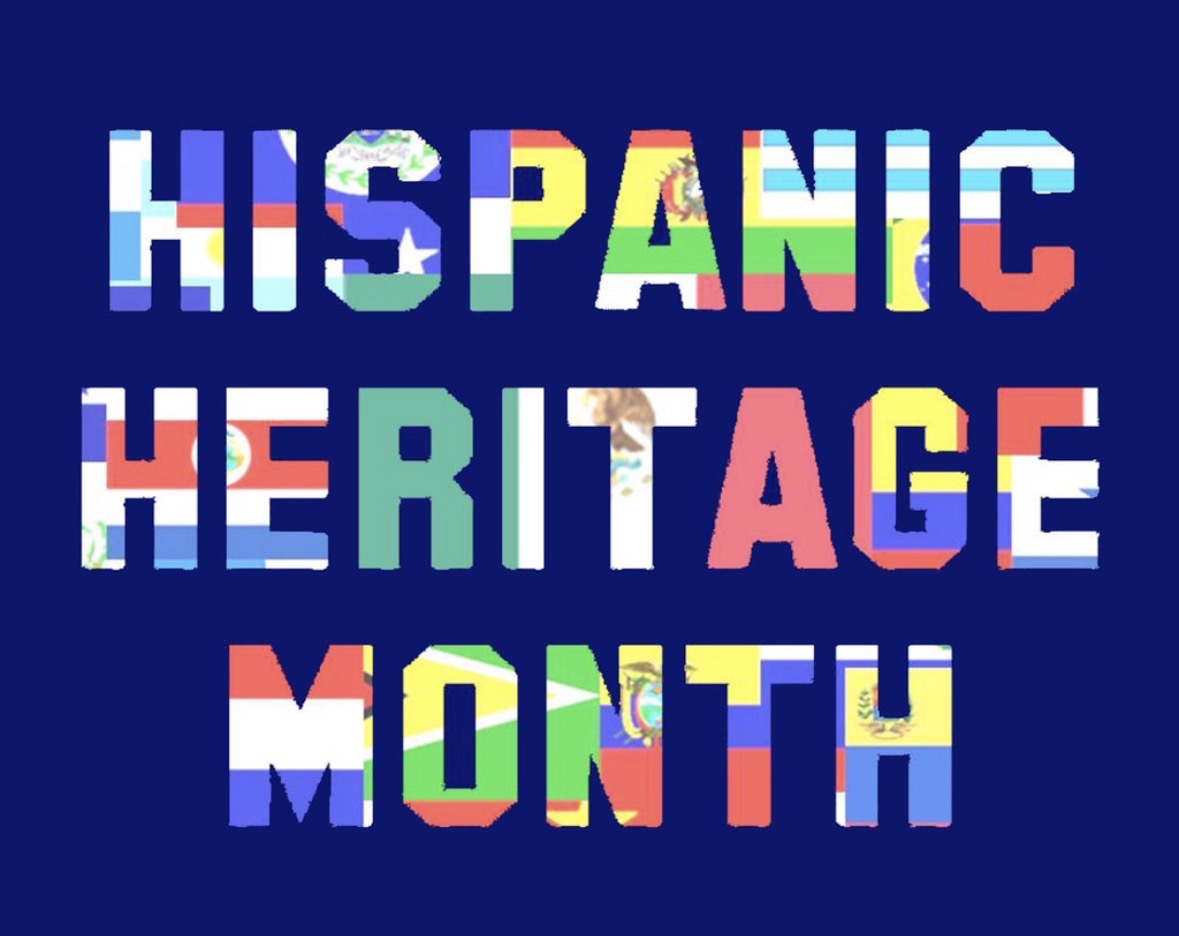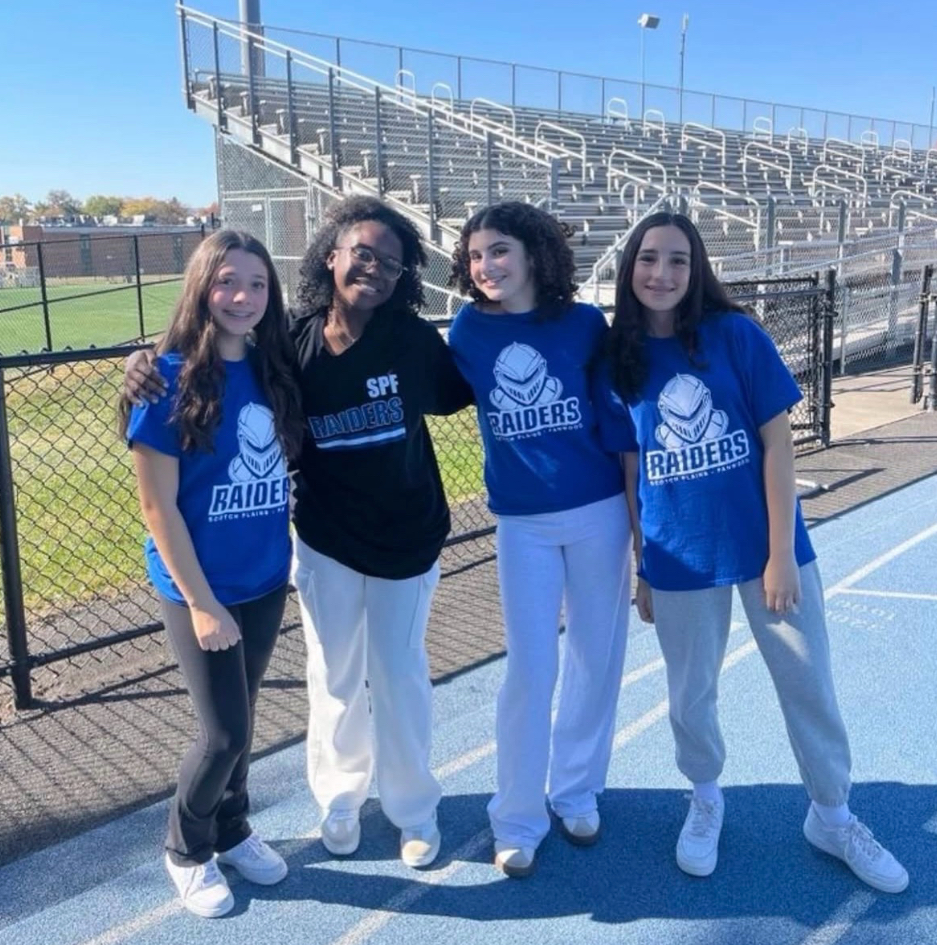The Performance Assessment Design Initiative class or P.A.D.I, is currently on its second year of implementation at Scotch Plains Fanwood High School. The class, which consists of two groups of 40 students, participate in an elongated periods of history and english classes back-to-back. The main goal of the class is to assess the question, “Can everyday citizens make a difference?”. To address this question, P.A.D.I teachers Heidi Novik, Amy Rutkowski, Colleen Gallagher, Victoria Vanoni, Susan Eryan and Jill Zarr work to together to create joint lesson plans that work cohesively between both classes. Assistant principal Brooke Esposito and media specialist Robin Stayvas also help out with the classes.
The PADI classes were most recently tasked with creating a project that addresses a social action that they were passionate about. Students chose an array of different topics to tackle which included animal abuse, gun control, body image, homelessness and veterans benefits. The students also came up with creative forms in which to address these issues. Some students chose to write an editorial to the Fanscotian about their specific topics, some of which are highlighted below.

From left to right, freshman and PADI students Isabella Lyons, Qadir Zara, JJ Dionisio. The classmates wrote editorials to the Fanscotian as a part of their class project.
Negative body image by Ben Freedman
Imagine a high school girl. In the bathroom. Forcing herself to throw up her dinner. Her phone is buzzing with messages like “YOU’RE TOO FAT” and “YOU’RE NOT SKINNY ENOUGH.” Sadly, this is now a common situation due to one major problem that has arisen–body image issues. The body image problem has been around for quite some time, but now with the rise of social media like Instagram and Snapchat, this problem has been brought into the limelight and it’s worse than ever. With celebrities flaunting their bodies all over social media, it paves the way for more harassment for everybody.
First, many factors can affect how people see their bodies whether it be negative or positive. For example, modern technology has changed the way we perceive ourselves. Social media and texting are just one of the influences that shape the ideals people create for themselves.
The Student Health Outreach & Promotion Center at the University of California- Santa Cruz discovered, “Studies at Stanford University and the University of Massachusetts found that 70% of college women say they feel worse about their own looks after reading women’s magazines and a 2006 study published in the Journal of Psychology of Men and Masculinity showed that…watching prime-time television and music videos appear to make men more uncomfortable with themselves.” The University of California–Santa Cruz found that other factors also may attribute to negative body image. They include, “Comments from family, friends and others about our, their, and other people’s bodies (both positive and negative), ideals that we develop about physical appearance,the frequency with which we compare ourselves to others, and exposure to images of idealized versus normal bodies.”
All of these can affect a person so much that they can develop a real problem known as Body Dysmorphic Disorder or B.D.D. In a 2010 New York Times article written by Jane Brody, she talks about B.D.D. She exposes the underbelly of the image problem by saying, “These brain changes may help explain how people can become overly focused on a perceived defect of their face, hair, skin or facial or body shape that others may not notice — indeed, that may not even exist. Some turn to alcohol and drugs to try to cope with the extreme distress. Others seek cosmetic surgery — which fails to relieve anxiety and can even make the problem worse, leaving scars where nothing was apparent before.” So what do we do with this huge problem facing us?
We have to stop it immediately. There are many ways to go about this. One way is to promote all body types as usual with no sugarcoating whatsoever. For example, Mattel produces Barbie dolls that have a “curvy” body model, but by identifying them as “curvy,” Mattel is destroying the very equal image they are trying to promote. If we are going to get rid of this problem, then we have to go to the source: the media. I’m not saying we have to change the world. I’m just saying that we should change how the media looks at all body types, show everyone that all body types are to be accepted and loved no matter their “flaws.” Advertisements, commercials, and men’s magazines have to include all body types and show that there is no “perfect image.” People need to find the error of their ways and realize that everyone is the same and can be loved no matter what they weigh or how they look. If we can do that, we can pave the way for a nicer and more accepting world. Until then, we can only dream. Remember, think twice before you hit send, because it might change someone for good.
Teen depression by Zach Lubeck
Suicide. It happens all too often. 34,000 people take their own lives each year according to the Huffington Post. Every 15 minutes someone jumps, pulls the trigger or kicks the chair. This is no laughing matter. People think the only way to end their suffering is to die. I was there. It was far more painful than any physical pain I have ever gone through. To live past suicide, it’s all mental. Depression takes a brain and destroys it, making someone think life is hopeless.
Not only do 34,000 people die, but in the United States, suicide is the 3rd leading cause of death for 15-24 year olds. That’s very young and I could have been under that. According to familydoctor.org children between the age of 12 and 18 are the most vulnerable to depression and suicidal thoughts. At age 12 depression hit, including the thoughts. Suicidal thoughts take a good life and make it seem like suffering. I felt that. The bullying. The hopelessness. The sadness. It went on for only a few weeks, but it almost killed me until it became literal. People need to know that it can be beat. Someone can have suicidal thoughts, and not end it all. It takes mental endurance, it takes fear, and it takes independence. I had no one that felt my pain. I was alone in a sea full of fish. I needed to get through it on my own. By my parents helped me when they found out and I was forced out of my thoughts in order to come back to school. Everyone made me feel bad for what I felt. I regret feeling guilty for suicide. I should have gotten help from friends who made me feel good, not guilty of depression. That was in November of my 7th grade year, But I remember every moment of it. The sadness. The bullying. It went too far. I’m not afraid to share my experience and am not afraid to share what it’s like. Even though it seemed like I was alone, I was not.
Depression is hidden and mostly not shown. It left a stain, a large stain, but I don’t try and get rid of it. That experience, even though terrible, taught me a lesson. No matter what comes my way, I can get through it. Even though for everyone else it came out of nowhere when people found out, there are some signs. Talking about suicide is a sign; also if someone has depression, that could mean the end is near. These signs are a cry for help and may be hints that someone may end their life soon.
The solution can’t help the world, but I propose a club to start here at the Scotch Plains Fanwood High School that can help the students. High school are critical years for one’s life. Depression can mess it up. The club will be designed for the students to talk and hopefully be able to help those who are depressed or are having suicidal thoughts. If you or your friend is in immediate danger, send an email to [email protected], our school social worker.
Getting together with others who feel the same can help students feeling hopeless. I will need to first have students interested in joining. If interested, email me at [email protected]. I will make the club as comforting as possible. You don’t have to feel bad for feeling the way that you do. Together as a club it can turn from bad feelings to good. We won’t just be talking about our feelings. We will talk about things we like in order to make one feel happy. We will also do some activities in order to build self confidence. Self confidence is key to getting over depression. Together as a club, we can help each other get stronger and make our lives better.
Harmful effects of media by Qadir Zara
In the modern age, media is a vast medium. It comes in numerous varieties, and everyone takes part in some form of media. This, although it may sound like a good thing, can lead to some negative effects. With media being everywhere and on everything, it’s spread to tons of people, sometimes bearing representations of certain things that are untrue. One major example of this is how gender is portrayed in the media. Because of the media, stereotypes are spread, popularized, and in many cases, accepted.
Now, you may be thinking, “Why is it such a big problem?” Surely people don’t just follow what they see on TV, or read online, right? Sadly, this is the case. Media perpetuates the idea of different genders being a certain way all over media, and targets a variety of demographics, including both children and adults. For example, on TV, men are typically shown to be masculine, strong, and leaders, while women are shown as weak, ditzy, or irrelevant. We know this to be true, but because of the popularity of the sources of these stereotypes, they’re widespread, and eventually, they end up being the norm. This is terrible, and it’s one of the main causes for gender roles being forced. Things that are shown to be normal over multiple different forms of media ending up being accepted by the majority of society. This confines people to try and strive to be something they might not want to be, but force themselves (Or are forced by others) to be because it’s “normal.” Another big issue with the spreading of these stereotypes is who is affected by and subjected to it. Anyone could see or be forced into gender stereotypes because of media. According to research done by The Nielsen Company, 96.7% of American families own a television, which is one of the main sources of media that spread this misinformation. In children’s commercials, gender roles and stereotypes are snuck in, whether it be something obvious, or something small. One example is a popular show, The Big Bang Theory. In its earlier airings, it only had one female lead, who was barely relevant, and just used as a love interest for the three male protagonists. An example of a commercial could be a Crayola sidewalk chalk commercial [Crayola Outdoor Colourful Beats], something that you’d assume to be gender-neutral. In the commercial, it depicts a group of girls all drawing with the chalk, while one boy, someone obviously made to be the main character of the commercial, raps and dances. It may not be something huge, but it’s still pushing the roles onto a product, which could have been easily avoided. Another example would be a commercial directed towards adults, something like beer. Very commonly, these commercials depict very masculine men, and/or women wearing revealing clothing. As you can see these commercials that create stereotypes like this are directed towards both adults and children, making its publicity even wider.
From the information I’ve given you, hopefully you now see what a big issue this is. If so, there’s only one more step you should take, and that’s trying to fix the problem. The main thing you can do is speak against it. Create awareness, and try to go as big as possible, and get people who are big in the media to move against it. There’s a plethora of writers and actors who feel strongly towards equality, speak out to them! If anyone can make a big impact on things in the media, it’s the people who take part in making it. If you want to try even bigger, speak out to the people who create shows, commercials, etcetera. Tell them there’s an issue with the way they write gender stereotypes into things, and encourage them to stop. There’s no definite way to stop this issue completely, but any little steps against it help.
The need for positive male role models by JJ Dioniso
When children are young, they’re almost guaranteed to be exposed to some form of entertainment. These shows and movies will have characters that can form the way a child acts for the rest of their lives. For boys, they need someone to look up to. Many times, the most prominent male role in entertainment is the comic relief. I’m not saying they can’t be funny, but they have to be there for more than just cracking a few jokes. Also, we need strong role models in entertainment for the sake of shaping the futures of boys. People are easily influenced by what they see and if boys are seeing the right things, they will have a positive future. A good role model is someone who is compassionate, mentally strong, and has realistic flaws that they work through to become a better person. Without a good male role model, boys will live a negative life. Everyone needs someone to look up to and with the sad world we live in, we need hope for the future and strong role models are the start.
The definition of a ‘real man’ is constantly changing and if entertainment doesn’t keep up with that, there will definitely be no more good male role models in the media. In Jack Myers’ article for the Huffington Post entitled, “How Media is Redefining Men and How Men are Redefining Media,” he says, “Several of today’s most popular male figures are shaped not by their aggressive, stereotypical take on masculinity, but on other factors altogether: their empathy, kindness, and intelligence. There’s still a place for ‘traditional’ masculinity, but it’s just one of several options.” He’s saying that some of the popular characters in entertainment today are fitting this new meld of a ‘man’. The media usually has it represented with no balance, so he’s either this character who is so weak physically and emotionally he’s useless, funny for the sake of comic relief, or an emotionless strong man with no flaws.
An example of a good role model for younger boys is Ash Ketchum from Pokemon. Ash starts off as an arrogant amateur trainer and throughout the series, he learns the values of friendship and trust. He learns all this through his own mistakes and it’s important for young boys to know that mistakes are fine, if you learn from them. Also, throughout the show, Ash becomes smarter by just doing his best and learning from it. But a bad example of a role model for younger is any character that goes out of their way to be mean to others. Though there aren’t many characters like that in shows for the younger crowd, it’s still something to look out for. For older boys, a good role model is Barry Allen/The Flash from The CW’s: The Flash. Barry is a character who gets blessed with extraordinary powers and he then uses them to protect his city. He’s very brave, but with that bravery comes some overconfidence. Sometimes Barry will run into a fight with no plan and get his butt kicked. But he learns from those mistakes and becomes smarter in the process. One of the best (in my opinion) parts of Barry’s character is how much he cares for his family and friends. It’s a great example of how you can still be strong and show emotion to those closest to you. An example of a bad role model for that age group would be Lucas from Stranger Things. Don’t get me wrong I love the show, but his character isn’t the best of people and doesn’t have many redeeming qualities. For starters from the beginning, he wants to get rid of Eleven for the sole reason that she’s different from the rest of the crew. He also has little to no development throughout the first season. He starts judging people for being different and he doesn’t move on from that. Lastly, for the teenage boys and above, Sergeant Terry Jeffords from Brooklyn Nine-Nine is a great example of how to be the old definition of a man and still be caring and strong mentally. In the show, there are many instances where Sgt. Jeffords shows his emotional side when he’s scared about bad things happening to his fellow officers in the precinct and when he’s nervous about his family. The best part is this man is ripped and seeing that type of emotion in a character that would traditionally have no emotion is truly beautiful. A bad example of a role model for teen boys could be generalized as any one-dimensional male who doesn’t treat everyone with respect. Whether it’s not treating a significant other correctly, or treating someone differently because their different, they’re a bad role model. Sometimes that type of character is the ‘bad guy’, but others times the writers decide that’s how a protagonist should act. That’s just not right and realizing that and not seeing that bad character as a role model is a path to success.
Turning on the TV is what many parents do to keep their kids occupied. The thing is they should be making sure their kids are watching a show that’s giving them someone to look up to. Many people would say that you shouldn’t look up to a fictional character, but I feel the opposite. These characters have distinct character traits that can be applied to their lives. Developing these traits through life can teach all boys how to live a life worth living. A life where you are loved because you love others and you are honored for honoring your education. Learning to care about the important parts of life is vital to becoming the best person you can be. Without this good role model, boys can end up making some choices that they’ll definitely regret down the line. It could be crime, drugs, or just being a bad person. Role models give us a goal of something to become, but a bad role model would just steer someone in the completely wrong direction. For all the parents of young boys reading this, make sure they’re looking up to the right guys. The ones with the traits of a man, someone who’s kind and strong in more ways than physically. And if you don’t have a young boy in your life, just remember everything said in this article for when that time comes when there’s a young boy in your life. Young boys need to learn to be a man, they have to be able to care for the ones they love.
Negative body image by Bella Lyons
Every girl has heard one of these phrases from her mother, her teacher, or her friend at least once in her lifetime: “Beauty is not skin deep,” “Beauty comes in all shapes and sizes,” or, “You’re beautiful in every way, so don’t compare yourself to other people.” We all find these quotes so cliche because of how many times we’ve heard them. But once we became fully aware of society’s “beauty standards” it’s like we completely forgot what we’ve been told all of our lives. Body image is the perception of one’s physical self, and ultimately whether or not they view themselves as physically acceptable. The main reason why people tend to be so self conscious is because they constantly compare themselves to other people. Usually, when people see the attention given to other people for a reason as simple as having a nice body, they convince themselves that if they don’t have the same feature, they need to change that feature about themselves in order to get the same type of attention or level of attention. This logic makes people not just look at themselves in the mirror differently, but examine themselves to figure out what they do or do not have in common with the people that they might idolize, and that’s when body image makes its way into people’s lives.
Although someone’s body image can be positive, it’s generally a negative thing among the majority of people. According to a webpage called, “11 Facts about Body Image,” body image can affect everyone, but 95% of the people it affects are people between the ages of 12 and 25. Teenagers and pre-teens often become very self conscious due to many things, including the way that their bodies are undergoing changes. 91% of adult women are not content with their bodies, so they often resort to dieting procedures. Not only do people become insecure by looking in a mirror, but they also become insecure through the body images that society is promoting. Social media plays a big role in everyone’s lives today. When people are constantly seeing a portrait of what might seem like the “perfect” body type, or “perfect” way to look, they then look at themselves as less than, and begin to feel less and less confident in themselves. According to Rachel Simmons, author of “How Social Media Is a Toxic Mirror”, Psychologists “found robust cross-cultural evidence linking social media use to body image concerns, dieting, body surveillance, a drive for thinness and self-objectification in adolescents.”
The truth of the matter is, there is no such thing as the perfect way to look, or a perfect body type. There is not one person in this world that is perfect. Sorry to break it to you, but you’re not perfect… but guess what, neither is the person next to you, and the person next to them, and the list of imperfect people goes on. People on social media tend to post the picture that they look best in. If you have ever taken a picture of yourself, or been in a picture with a group of people, you probably know very well that the picture always needs to be retaken at least once because someone didn’t look “perfect” in the moment that the picture was taken. That’s the thing about what how people put themselves out there; they will do anything to make other people believe that they are flawless. They’ll do anything to get the highest amount of likes and comments, but most times, the image they’re putting out there of themselves is not realistic. Believe it or not, the celebrities that everyone idolizes for their looks are imperfect too. Even the people who seem flawless have flaws, and just because the image they put out there of themselves seems like they’re immaculate, they have what people call “bad sides” just like everyone else. People become so oblivious to the fact that these people look perfect in every way, that people start saying things like, “I wish I had the same body as…” or “I wish I looked like her.” After that happens, they tend to start pointing things out within themselves that they don’t like, making them insecure about the way that they look.
Models are gorgeous. I think we can all agree that the majority the models out there are absolutely stunning, but they all generally have the same type of features. People often feel pressured to look like most of the models out there, and if they don’t, they feel like they need to change in order to be seen as beautiful. The literal definition of model is: a system or thing used as an example to follow or imitate. No wonder why people feel so obligated to look the same as their favorite celebrities. Typically, when people are asked to explain what they see as a model type of person, they answer saying something along the lines of, “for females models, they’re usually thin, yet somewhat curvy, but not overly curvy, and tend to have great skin.” For males, the usual model is toned in at least one way, whether they have abs, giant biceps, or sharp jawlines, and they also tend to have clear skin. Again, that’s the typical answer that people give when they’re asked what models should or do look like. Yes, there are other models out there such as “Plus sized models,” or “Tall models,” but these models are labelled, as if they don’t fit in with the “normal classification” of models. People often don’t care as much about these types of models because of their label, and that’s extremely unfair. They’re models, and even though there is a classification due to the type of clothing they might model that does not mean that they as people should be classified like that. There is no perfect body type, and when people compare themselves to typical models, they often end up creating a negative body image about themselves which can be a difficult thing to get rid of. In society today, it can be difficult to sort out the truth of beautiful people through the standards that are set so high.
If people begin to realize that perfect isn’t a thing, and no one is perfect then so many people would be more content with themselves, allowing people to be ultimately happier throughout their everyday lives. This idea of happiness is what is truly beautiful. So get out there and find what makes you happy. Put people in your life that make you feel confident about yourself, and do what you love. A growing population of happy people is what will make this world truly beautiful.
Teen social media addiction by Jamie Valian
”Okay Mom! One second! I’m coming!” Recognize these words? You have to admit, most days you ruin life moments due to being distracted by your phone. Even the smallest check of notifications could leave you with ten minutes wasted on your cell phone. Whether it’s a click, snap, or phone call, people are constantly connected to the internet. But, how connected can you be before it’s too much? While technology has innovated and changed our world forever, is it best for the teenagers of this generation to grow up in this type of media-filled society? Social media is turning into an addiction for teenagers and it is only growing.
Keeping up with social media is a constant struggle. It is always changing and falling behind could actually hurt you. Speaking of hurting you, social media can actually cause mental pain. In a recent article, author Ana Homayoun, a writer of The New York Times, expresses the deep and dark sides of cell phone and how they are slowly taking over the lives of teens. She states, “Secret Facebook groups remain unsearchable, and members can only be added or invited by another member.” This explains how people can privately make messages and can allow conversation to be hiddened which can create drama and rumors. We are surrounded by a world that needs social media to thrive. But is our deep crave worth the health of the future generations?
Although we are constantly are thinking about the future, we need to focus on the problem at hand. Friendships and just basic face-to-face relationships are constantly being challenged due to the obsession of cell phones. In 2015, Professor Larry D. Rosen from California State University wrote an article based on how Social Networking is mentally hurting the millennials. He states, “Technology addicts use their devices or the Internet from 40 to 80 hours per week, or they might go on “net binges” in which a single session can last up to 20 hours or more”. This article explains some damaging factors of using cell phones and how it is severely causing problems for the general public. It also says how people are becoming overly attached to their phones and constantly uploading something online. We don’t even realize the amount of time and usage we consume on our devices which takes away from our daily lifestyle.
So you are sitting at lunch with some of your closest friends and all the sudden your phone buzzes. Do you shun the conversation and distract yourself from the world around you or do you ignore your phone obsession and be the generation that overcomes social media? At the end of the day, your own actions will be the only thing hurting or helping you, but it’s the direction that you can chose which will decide your future. So do Mom a favor, and put the phone down.
Freshman Roy McGowan created a website about the benefits of eating organic food. He includes posts about how to shop for organic foods, which fruits and veggies you should buy organic or not and more.
https://roymcgowan14.wixsite.com/website








